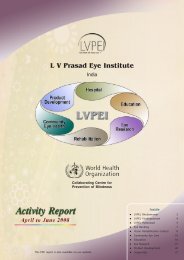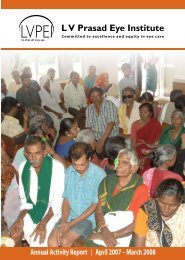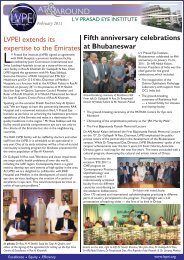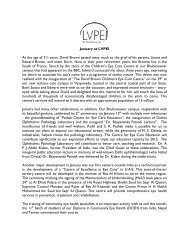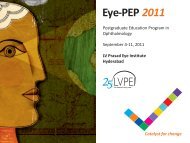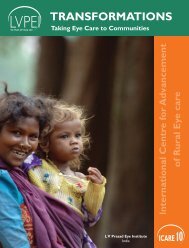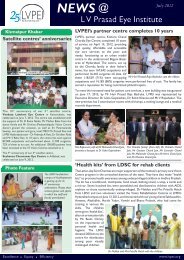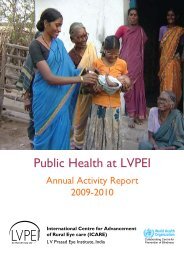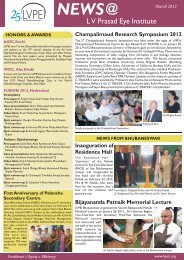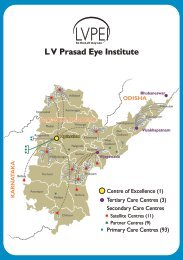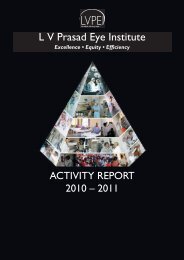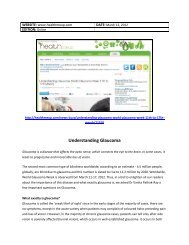IERG Abstracrt Book.indd - LV Prasad Eye Institute
IERG Abstracrt Book.indd - LV Prasad Eye Institute
IERG Abstracrt Book.indd - LV Prasad Eye Institute
You also want an ePaper? Increase the reach of your titles
YUMPU automatically turns print PDFs into web optimized ePapers that Google loves.
82 Basic Poster Sessionswere miR-885-5p, miR-585, miR-640, miR512-5p, miR-556-5p, miR135b*, miR-325, miR-99a*,miR-33a. In our target prediction study we have observed that KISS1, a cytoplasmic metastasissuppressor gene is targeted by miR-497. MiR-556-5p targets tumor protein p53 and miR-19b1targets retinoblastoma associated protein.Conclusions: The presence of these miRNA’s can be used as the biomarker which canpredict the metastasis at the earliest and initiate for the systematic prophylaxis. In addition,these results may provide new insights into the role of miRNAs in tumor progression and themetastatic phenotype. However, further studies in the larger cohort will be done to validatethese oncomirs and their functional role in melanoma.IBP 035Co-culture of Autologous Limbal and Conjunctival Epithelial Cells to Treat SevereOcular Surface Disorders: Long-term Survival AnalysisSandhya Subramaniam, 1 Kunjal Sejpal, 2 Anees Fatima, 3 Subhash Gaddipati, 4 Geeta Vemuganti, 4Virender Sangwan 21Prof. Brien Holden <strong>Eye</strong> Research Center, 2 Cornea and Anterior Segment Services, L V <strong>Prasad</strong> <strong>Eye</strong><strong>Institute</strong>, Hyderabad, 3 Department of Dermatology, Feinberg School of Medicine, NorthwesternUniversity, Chicago IL, 4 Sudhakar and Sreekanth Ravi Stem Cell Biology Laboratory,L V <strong>Prasad</strong> <strong>Eye</strong> <strong>Institute</strong>, Hyderabad, IndiaPurpose: The purpose of the study is to describe the long-term survival of an alternatemethod of ocular surface reconstruction in severe cases involving both limbus and conjunctiva,by co-cultivating limbal and conjunctival epithelium on a single substrate.Methods: After standardization of the technique, co-cultivated epithelial transplantationwas performed in 40 eyes of 39 patients with severe LSCD and conjunctival scarring orsymblepharon. Autologous limbal and conjunctival biopsy were cultured on human amnioticmembrane by the explant technique using a self designed Perspex ring barrier to segregate thecentral limbal and peripheral conjunctival epithelia in-vitro. Stability was defined as absence ofconjunctivalization in the central 4mm with no fluorescein staining. Penetrating keratoplasty(PKP) was subsequently performed when indicated.Results: The median survival time of co-cultivated epithelial transplantation was 48 months(95% CI: 6 to 90) by Kaplan-Meier analysis (Mean follow-up duration: 33 29 months, range:1 – 87). The probability of survival was 60% at 1 year and 45% at four years. BCVA improved togreater than 20/200 in 38% eyes at the last follow-up, compared to 5% eyes before surgery. PKPperformed at a mean duration of 12 6 months following co-cultivated transplantation, wassuccessful in 7 out of 10 eyes. Immunohistochemistry in five of the corneal buttons excised,showed an epithelial phenotype similar to cornea in all five.Conclusions: Synchronous use of cultured limbal and conjunctival epithelium offers a feasiblealternative and a simpler one-step surgical approach to treat severe ocular surface disordersinvolving limbus and conjunctiva.



